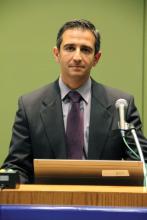CHICAGO – Same-day bundling of endoscopic procedures offers several important advantages, yet bundling was not used for 37% of procedures in a national sample of Medicare patients who had both colonoscopy and upper endoscopy within 180 days.
Moreover, the two procedures were separated from each other by a median of only 26 days, and nearly 30% of procedures that were not performed on the same day were separated by just 4 days or less.
"The lack of bundling was unlikely to be explained by clinical necessity," lead investigator Dr. Hashem B. El-Serag said at the annual Digestive Disease Week. "The financial implications to the health care system and the increased adverse events in patients are likely to be large," he stated.
Although bundling is convenient for patients, efficient for providers, and offers cost savings to the health care system, there is a financial disincentive for physicians to embrace this approach.
Reimbursement by Medicare for bundled procedures occurs at a rate that is less than the sum of the two procedures when they are charged separately. For example, reimbursement for a diagnostic upper endoscopy, or esophagogastroduodenoscopy (EGD) is just $75 when bundled and $150 when not bundled, while an upper GI endoscopic biopsy is $88 bundled vs. $177 when not bundled, explained Dr. El-Serag, professor of medicine and chief of gastroenterology and hepatology at Baylor College of Medicine in Houston.
The researchers examined 2007 outpatient Medicare claims from a 5% random sample of patients who lived in one of the Surveillance, Epidemiology and End Results (SEER) database regions. They then identified 12,905 Medicare beneficiaries who underwent both a colonoscopy and EGD within 180 days of each other. Patients who were not enrolled in Medicare parts A and B or were members of an HMO were excluded.
Based on ICD-9 codes, potential clinical indications for colonoscopy included evidence of GI bleeding such as anemia, heme-positive stool, hemorrhage of the rectum and anus, and iron deficiency; colon symptoms such as abdominal mass, distention, pain or mass, anorexia, bowel obstruction, change in bowel habits, constipation, diarrhea, fecal incontinence, weight loss, and nausea and vomiting; and colon surveillance in the presence of Crohn’s disease or a personal history of colorectal cancer, colon polyps, or ulcerative colitis.
Indications for EGD included signs of GI bleeding and upper GI symptoms. The median age of the patients was 75 years, 63% were female, and 79% were white.
In all, 8,100 procedures (63%) were bundled on the same day, 2,624 (20%) were performed within 30 days of each other, and 2,181 (17%) were performed within 31-180 days of each other, Dr. El-Serag said.
Nearly 30% of the 4,805 procedures that were not bundled were performed within 4 days of each other, with another 10% performed within 12 days of each other and 5% or less performed 44 or more days apart.
"Most procedures that were not bundled were performed reasonably close to each other," he said.
There were no significant differences between the three groups of patients – those who had bundled procedures, those who had them within 30 days, and those who had them within 31-180 days – with regard to gender or age. Patients who had bundled procedures, however, were less likely to be black (7.3% for bundled vs. 10.7% within 1-30 days vs. 7.5% within 31-180 days) or to live in a metropolitan area (82% vs. 87% vs. 87%, respectively).
An indication of GI bleeding was more likely in patients who had bundling, Dr. El-Serag said. Also, patients with bundled procedures were less likely to have screening as an indication, compared with patients whose procedures were not bundled.
Limitations of the study include possible inaccuracies in coding for some of the determinants, residual confounding by uncollectible factors such as patient preference or doctor’s advice, and generalizability. Strengths of the study are its population-based design that reflects a wide array of practices, its large sample size, and its complete capture of procedures in a non-HMO population, he said.
During a discussion of the study, an attendee asked how the researchers could be certain that an upper endoscopy performed 3 weeks after a colonoscopy was done for an indication known at the time of the first procedure. Dr. El-Serag replied that, while they couldn’t be absolutely certain when the additional indication popped into the chart, the 30-day window reduced the possibility of an emergent diagnosis requiring an additional procedure in the majority of cases.
"So you can be quite safe that for anything done within 30 days of each other, there was nothing new," he said.

